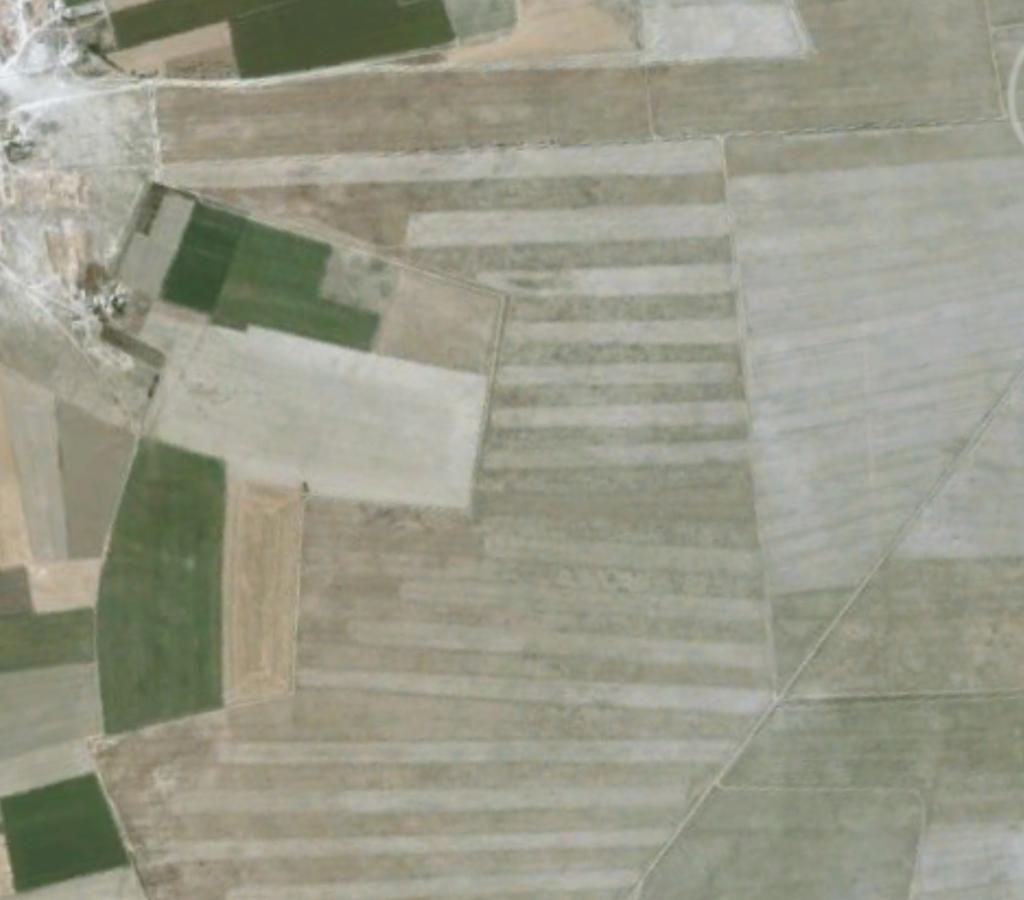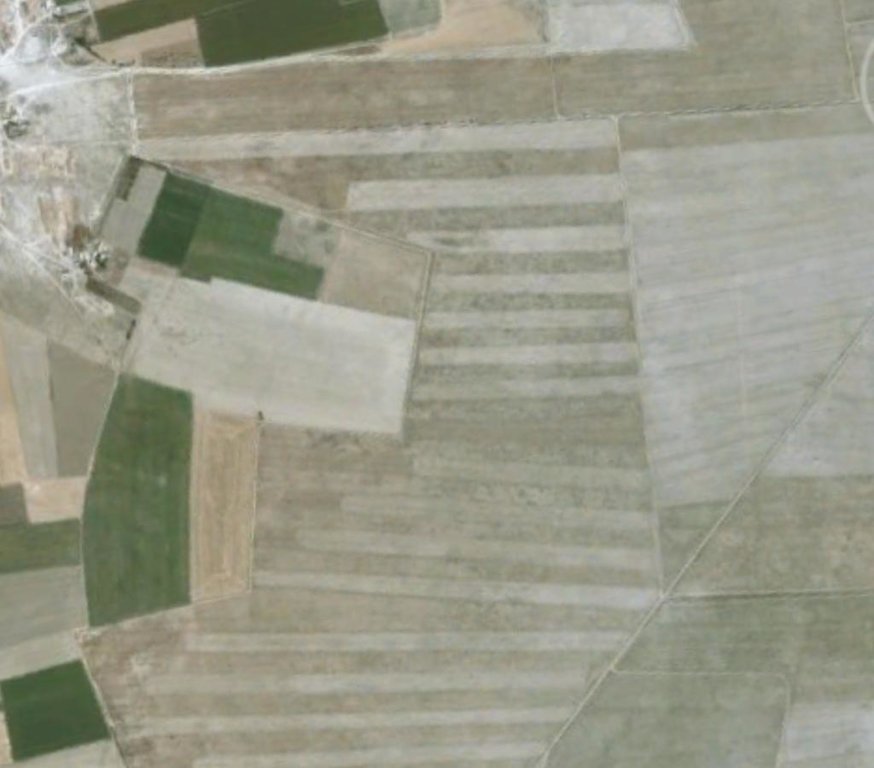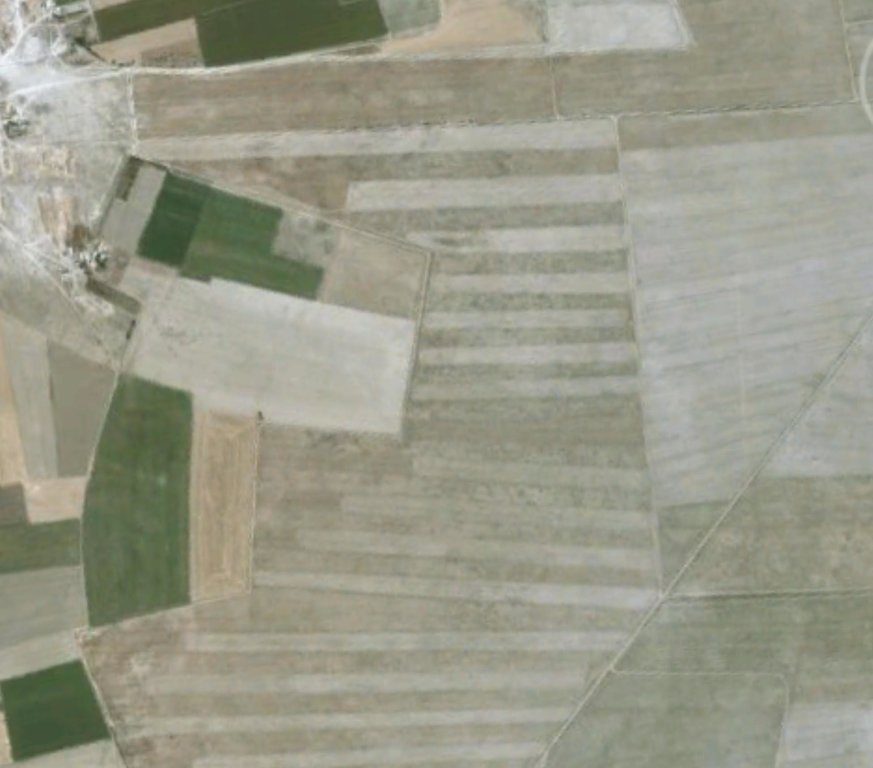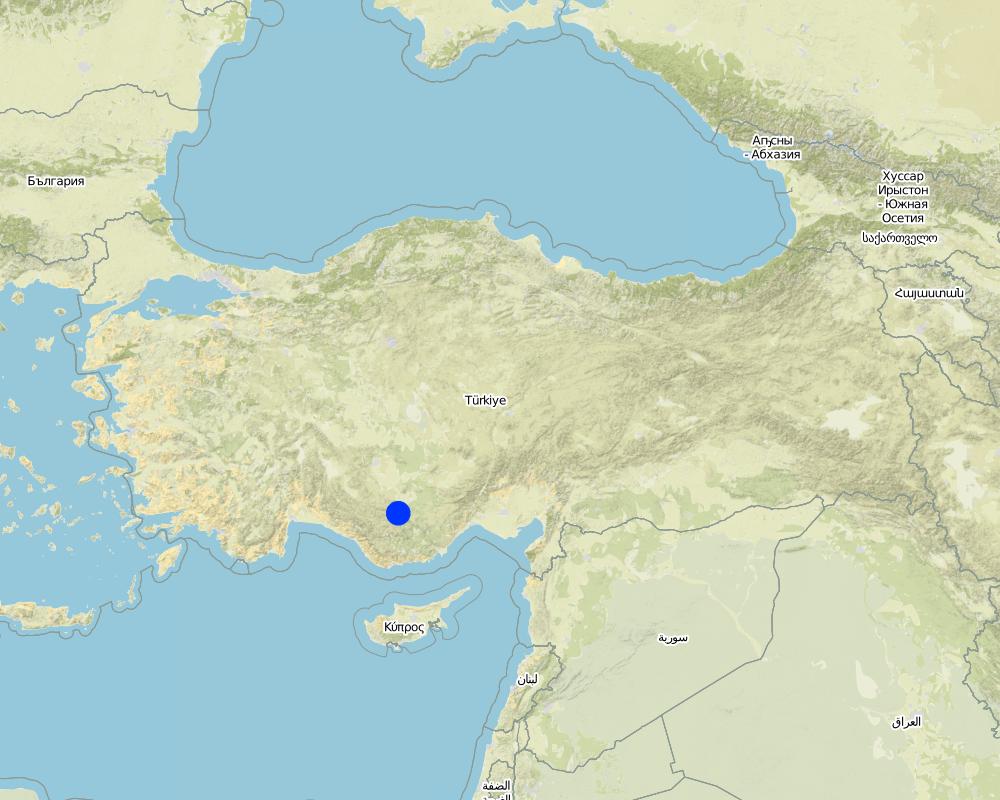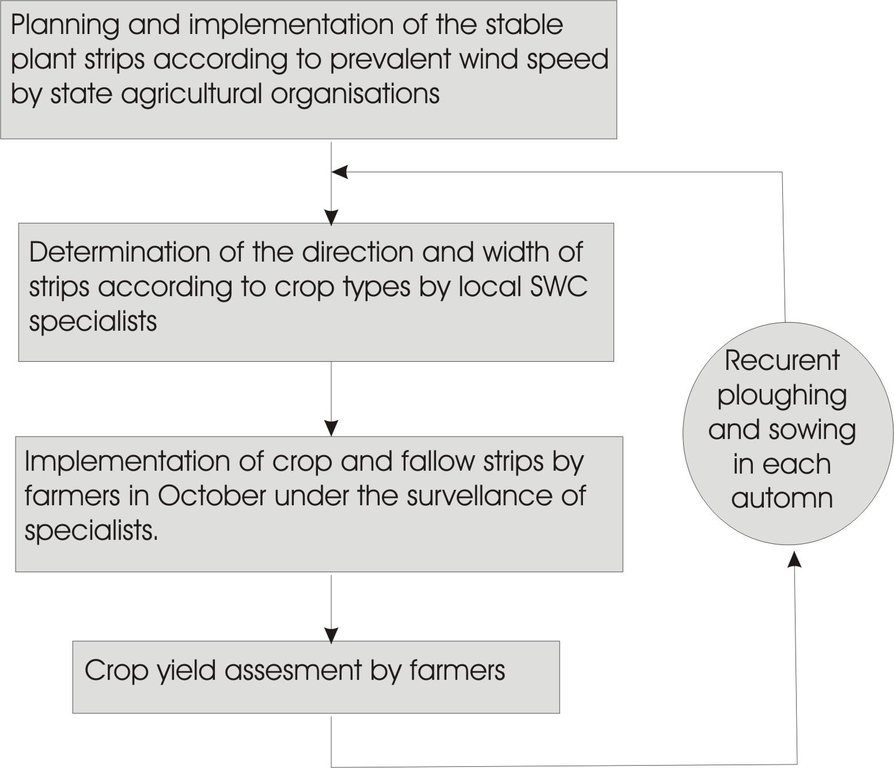Crop Production [Türkiye]
- Creation:
- Update:
- Compiler: Mehmet Zengin
- Editor: –
- Reviewer: Fabian Ottiger
approaches_2423 - Türkiye
View sections
Expand all Collapse all1. General information
1.2 Contact details of resource persons and institutions involved in the assessment and documentation of the Approach
Name of the institution(s) which facilitated the documentation/ evaluation of the Approach (if relevant)
University of Selcuk, Faculty of Agriculture (University of Selcuk, Faculty of Agriculture) - Türkiye1.3 Conditions regarding the use of data documented through WOCAT
The compiler and key resource person(s) accept the conditions regarding the use of data documented through WOCAT:
Ja
1.4 Reference(s) to Questionnaire(s) on SLM Technologies
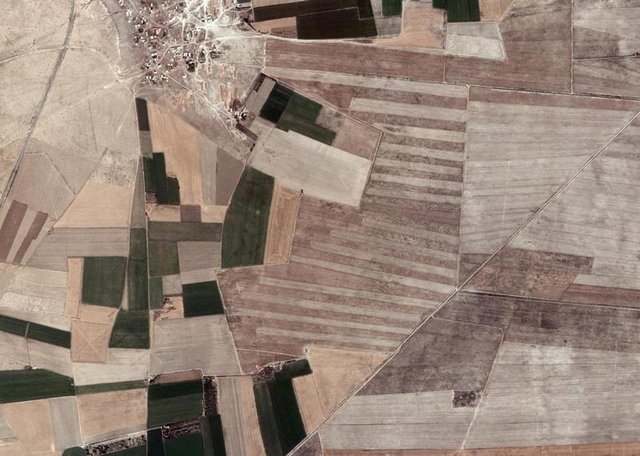
Strip farming [Türkiye]
Strip farming is a kind of an agriculture method that cereals are sowed as strips which are 50 m witdh (strip-fallow-strip). Strips are perpendicular to wind direction in dropugth areas.
- Compiler: Mehmet Zengin
2. Description of the SLM Approach
2.1 Short description of the Approach
Adopting of the strip cropping-fallow-strip cropping system by farmers, with support from local SWC specialists and state agricultural organisations.
2.2 Detailed description of the Approach
Detailed description of the Approach:
Aims / objectives: To prevent soil erosion by wind and enhance crop yield. Basically altered fallow strips serve the retention of soil particles and minimize wind erosion. Plant strips in combination of cerela strips further decrease the wind speed.
Methods: Planning and implementation of strip technology. To sow cereals as strips of 50 m wide perpendicular to wind direction, behind it fallow again plant strip. So wind speed decrease and soil loss is minimized.
Stages of implementation: Every year this method is applied on October. Fallow and cereal strips are changed each year.
Role of stakeholders: The state agricultural organisations plan and implement the stable plant strips according prevalent wind speed. The local SWC specialists determine the direction and width of the strips according the crop types. They also supervise the implementation. Farmers are expected to implement the strips, following the direction and width of strips and to asess crop yield.
2.3 Photos of the Approach
2.5 Country/ region/ locations where the Approach has been applied
Country:
Türkiye
Region/ State/ Province:
Konya
Further specification of location:
Karapınar
Map
×2.7 Type of Approach
- traditional/ indigenous
2.8 Main aims/ objectives of the Approach
The Approach focused on SLM only
To enable land users to conserve the soil from wind erosion
The SLM Approach addressed the following problems: Lack of technical knowledge.
2.9 Conditions enabling or hindering implementation of the Technology/ Technologies applied under the Approach
legal framework (land tenure, land and water use rights)
- enabling
The existing land ownership, land use rights / water rights helped a little the approach implementation: No problem, because farmers can easily apply the approach in their fields.
knowledge about SLM, access to technical support
- hindering
Farmers can not give the benefits of measures since lack of knowledge
Treatment through the SLM Approach: more rigorous information should be given
3. Participation and roles of stakeholders involved
3.1 Stakeholders involved in the Approach and their roles
- local land users/ local communities
Women are not a part of planning and implementation of strip farming. They are passivelly involved in certain secondary activities such as weeding etc.
Farmers applied strip farming method with the help of SWC spelialist.
- SLM specialists/ agricultural advisers
- national government (planners, decision-makers)
3.2 Involvement of local land users/ local communities in the different phases of the Approach
| Involvement of local land users/ local communities | Specify who was involved and describe activities | |
|---|---|---|
| initiation/ motivation | none | |
| planning | none | |
| implementation | interactive | Implemantion is basically done by individual land owners with consulancy of SWC specialist |
| monitoring/ evaluation | interactive | |
| Research | none |
3.3 Flow chart (if available)
Description:
Flow chart for crop production by strip farming
Author:
Mehmet Zengin (Ziraat Fakültesi, Selçuk Üniversitesi, Konya)
3.4 Decision-making on the selection of SLM Technology/ Technologies
Specify who decided on the selection of the Technology/ Technologies to be implemented:
- SLM specialists alone
Explain:
Specialist from state organizations determine the most suffered wind erosion areas and make some protection plans. These plans are realised by land users which are consulted by SWC specialists.
Decisions on the method of implementing the SLM Technology were made by by SLM specialists alone (top-down)
4. Technical support, capacity building, and knowledge management
4.1 Capacity building/ training
Was training provided to land users/ other stakeholders?
Ja
Specify who was trained:
- land users
- field staff/ advisers
If relevant, specify gender, age, status, ethnicity, etc.
Only male farmers attend the training meetings.
Form of training:
- demonstration areas
- public meetings
- courses
4.2 Advisory service
Do land users have access to an advisory service?
Ja
Describe/ comments:
Advisory service is quite adequate to ensure the continuation of land conservation activities
4.3 Institution strengthening (organizational development)
Have institutions been established or strengthened through the Approach?
- yes, greatly
Specify the level(s) at which institutions have been strengthened or established:
- local
Specify type of support:
- capacity building/ training
- equipment
4.4 Monitoring and evaluation
Is monitoring and evaluation part of the Approach?
Ja
Comments:
bio-physical aspects were ad hoc monitored through measurements; indicators: soil loss by wind
economic / production aspects were ad hoc monitored through measurements; indicators: wheat yield
There were few changes in the Approach as a result of monitoring and evaluation: Farmers understand the efficacy of strip cropping in prevention of wind erosion.
4.5 Research
Was research part of the Approach?
Ja
Specify topics:
- ecology
Give further details and indicate who did the research:
SWC specialists studied the effects of strip cropping on soil loss.
Research was carried out on station
5. Financing and external material support
5.1 Annual budget for the SLM component of the Approach
If precise annual budget is not known, indicate range:
- 2,000-10,000
Comments (e.g. main sources of funding/ major donors):
Approach costs were met by the following donors: government (Planning, applying, material): 20.0%; local community / land user(s) (implementation of the approach): 80.0%
5.2 Financial/ material support provided to land users
Did land users receive financial/ material support for implementing the Technology/ Technologies?
Ja
5.3 Subsidies for specific inputs (including labour)
- equipment
| Specify which inputs were subsidised | To which extent | Specify subsidies |
|---|---|---|
| machinery | partly financed | |
- agricultural
| Specify which inputs were subsidised | To which extent | Specify subsidies |
|---|---|---|
| seeds | partly financed | |
| fertilizers | partly financed | |
If labour by land users was a substantial input, was it:
- food-for-work
Comments:
Also voluntary
5.4 Credit
Was credit provided under the Approach for SLM activities?
Nee
6. Impact analysis and concluding statements
6.1 Impacts of the Approach
Did the Approach help land users to implement and maintain SLM Technologies?
- No
- Yes, little
- Yes, moderately
- Yes, greatly
Strip cropping system was appreciated by the farmers.
Did the Approach improve issues of land tenure/ user rights that hindered implementation of SLM Technologies?
- No
- Yes, little
- Yes, moderately
- Yes, greatly
Farmers could not give up their habits of sowing a field completely. The problem is likely to be overcome in the near future. Training, course, demonstrations by the govenment perhaps will encourage the farmers in applying this technique.
Did other land users / projects adopt the Approach?
- No
- Yes, little
- Yes, moderately
- Yes, greatly
Farmers around settlements heard and visited strip farming system for plant production and conservation of wind erosion and liked and adopted it.
6.2 Main motivation of land users to implement SLM
- increased profit(ability), improved cost-benefit-ratio
- prestige, social pressure/ social cohesion
- environmental consciousness
6.3 Sustainability of Approach activities
Can the land users sustain what has been implemented through the Approach (without external support)?
- yes
6.4 Strengths/ advantages of the Approach
| Strengths/ advantages/ opportunities in the land user’s view |
|---|
| This approach is usefull to conserve wind erosion, but we can not give up our customs. (How to sustain/ enhance this strength: Field experiments, demonstrations and training.) |
| Strengths/ advantages/ opportunities in the compiler’s or other key resource person’s view |
|---|
| Plant crop approach was successfull for strip farming system in the wind region. (How to sustain/ enhance this strength: It is necessary law/rule/forcing.) |
6.5 Weaknesses/ disadvantages of the Approach and ways of overcoming them
| Weaknesses/ disadvantages/ risks in the land user’s view | How can they be overcome? |
|---|---|
| It is difficult partail sowing in some field. Moreover area required for fallow is an important weakness. | By the encouragements. |
| Weaknesses/ disadvantages/ risks in the compiler’s or other key resource person’s view | How can they be overcome? |
|---|---|
| Adoption and application of this measure by farmers are difficult due to sociological reasons. | By training and demonstration. |
7. References and links
7.1 Methods/ sources of information
- field visits, field surveys
- interviews with land users
Links and modules
Expand all Collapse allLinks

Strip farming [Türkiye]
Strip farming is a kind of an agriculture method that cereals are sowed as strips which are 50 m witdh (strip-fallow-strip). Strips are perpendicular to wind direction in dropugth areas.
- Compiler: Mehmet Zengin
Modules
No modules


